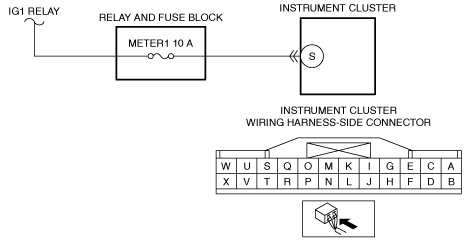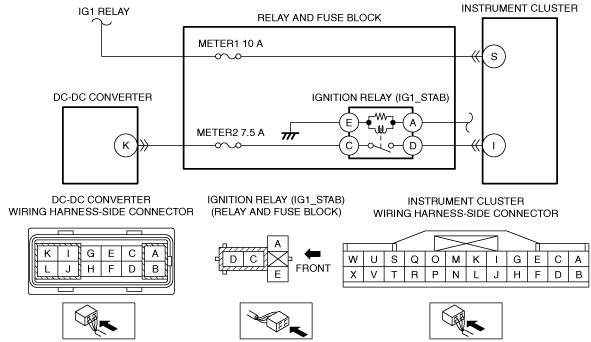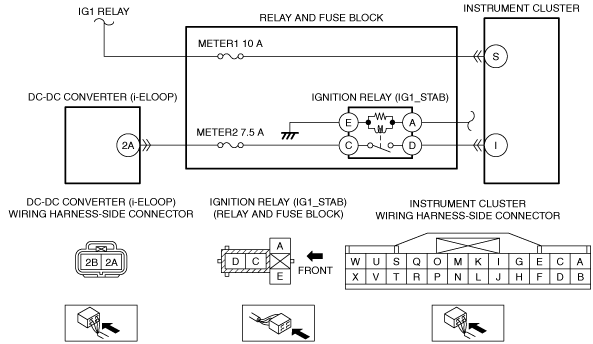|
1
|
VERIFY PCM DTCs
• Retrieve the PCM DTCs using the M-MDS.
• Are any DTCs displayed?
|
Yes
|
Repair or replace the malfunctioning part according to the applicable DTC troubleshooting.
|
|
No
|
Go to the next step.
|
|
2
|
INSPECT BATTERY
• Is the battery normal?
|
Yes
|
Go to the next step.
|
|
No
|
Recharge or replace the battery, then go to Step 11.
|
|
3
|
INSPECT GENERATOR
• Is the generator normal?
|
Yes
|
Go to the next step.
|
|
No
|
Replace the generator, then go to Step 11.
|
|
4
|
INSPECT INSTRUMENT CLUSTER CONNECTOR CONDITION
• Switch the ignition off.
• Disconnect the negative battery cable.
• Disconnect the instrument cluster connector.
• Inspect the connector engagement and connection condition and inspect the terminals for damage, deformation, corrosion, or disconnection.
• Is the connector normal?
|
Yes
|
Go to the next step.
|
|
No
|
Repair or replace the connector, then go to Step 11.
|
|
5
|
VERIFY INSTRUMENT CLUSTER POWER SUPPLY VOLTAGE
• Always reconnect all disconnected connectors.
• Reconnect the negative battery cable.
• Display the PID VPWR using the M-MDS.
• Is the voltage B+?
|
Yes
|
Go to the next step.
|
|
No
|
Inspect the METER1 10 A fuse.
• If the fuse is blown:
-
― Refer to the wiring diagram and verify whether or not there is a common connector between METER1 10 A fuse and instrument cluster terminal S.
If there is a common connector:
-
• Determine the malfunctioning part by inspecting the common connector and the terminal for corrosion, damage, or pin disconnection, and the common wiring harness for a short to ground.
• Repair or replace the malfunctioning part.
If there is no common connector:
-
• Repair or replace the wiring harness which has a short to ground.
• Replace the fuse.
• If the fuse is damaged:
-
― Replace the fuse.
• If the fuse is normal:
-
― Refer to the wiring diagram and verify whether or not there is a common connector between IG1 relay and instrument cluster terminal S.
If there is a common connector:
-
• Determine the malfunctioning part by inspecting the common connector and the terminal for corrosion, damage, or pin disconnection, and the common wiring harness for an open circuit.
• Repair or replace the malfunctioning part.
If there is no common connector:
-
• Repair or replace the wiring harness which has an open circuit.
Go to Step 11.
|
|
6
|
INSPECT IGNITION RELAY (IG1_STAB)
• Switch the ignition off.
• Disconnect the negative battery cable.
• Remove the ignition relay (IG1_STAB).
• Inspect the ignition relay (IG1_STAB).
• Is the ignition relay (IG1_STAB) normal?
|
Yes
|
Go to the next step.
|
|
No
|
Replace the ignition relay (IG1_STAB), then go to Step 11.
|
|
7
|
INSPECT DC-DC CONVERTER (i-ELOOP) CONNECTOR CONDITION
• Disconnect the service plug.
• Disconnect the DC-DC converter (i-ELOOP) connector.
• Inspect the connector engagement and connection condition and inspect the terminals for damage, deformation, corrosion, or disconnection.
• Is the connector normal?
|
Yes
|
Go to the next step.
|
|
No
|
Repair or replace the connector, then go to Step 11.
|
|
8
|
INSPECT FOR SHORT TO GROUND IN WIRING HARNESS BETWEEN DC-DC CONVERTER (i-ELOOP) AND INSTRUMENT CLUSTER
• Verify that the DC-DC converter (i-ELOOP) connector is disconnected.
• Disconnect the instrument cluster connector.
• Inspect for continuity between the following terminals (wiring harness-side) and body ground:
-
― Ignition relay (IG1_STAB) terminal C
― Instrument cluster terminal I
• Is there continuity?
|
Yes
|
Inspect the METER2 7.5 A fuse.
• If the fuse is blown:
-
― Refer to the wiring diagram and verify whether or not there is a common connector between following:
-
• METER2 7.5 A fuse—Ignition relay (IG1_STAB) terminal C
• Ignition relay (IG1_STAB) terminal D—Instrument cluster terminal I
If there is a common connector:
-
• Determine the malfunctioning part by inspecting the common connector and the terminal for corrosion, damage, or pin disconnection, and the common wiring harness for a short to ground.
• Repair or replace the malfunctioning part.
If there is no common connector:
-
• Repair or replace the wiring harness which has a short to ground.
• Replace the fuse.
• If the fuse is damaged:
-
― Replace the fuse.
Go to Step 11.
|
|
No
|
Go to the next step.
|
|
9
|
INSPECT FOR OPEN CIRCUIT IN WIRING HARNESS BETWEEN DC-DC CONVERTER (i-ELOOP) AND INSTRUMENT CLUSTER
• Verify that the instrument cluster and DC-DC converter (i-ELOOP) connectors are disconnected.
• Inspect for continuity between the following terminals (wiring harness-side):
-
― DC-DC converter (i-ELOOP) terminal 2A—Ignition relay (IG1_STAB) terminal C
― Ignition relay (IG1_STAB) terminal D—Instrument cluster terminal I
• Is there continuity?
|
Yes
|
Go to the next step.
|
|
No
|
Inspect the METER2 7.5 A fuse.
• If the fuse is damaged:
-
― Replace the fuse.
• If the fuse is normal:
-
― Refer to the wiring diagram and verify whether or not there is a common connector between following:
-
• DC-DC converter (i-ELOOP) terminal 2A—Ignition relay (IG1_STAB) terminal C
• Ignition relay (IG1_STAB) terminal D—Instrument cluster terminal I
If there is a common connector:
-
• Determine the malfunctioning part by inspecting the common connector and the terminal for corrosion, damage, or pin disconnection, and the common wiring harness for an open circuit.
• Repair or replace the malfunctioning part.
If there is no common connector:
-
• Repair or replace the wiring harness which has an open circuit.
Go to Step 11.
|
|
10
|
INSPECT DC-DC CONVERTER (i-ELOOP)
• Inspect the DC-DC converter (i-ELOOP).
• Is the DC-DC converter (i-ELOOP) normal?
|
Yes
|
Go to the next step.
|
|
No
|
Replace the DC-DC converter (i-ELOOP), then go to the next step.
|
|
11
|
VERIFY THAT REPAIRS HAVE BEEN COMPLETED
• Always reconnect all disconnected connectors.
• Reconnect the service plug.
• Reconnect the negative battery cable.
• Clear the DTC for the instrument cluster using the M-MDS.
• Retrieve the instrument cluster DTCs using the M-MDS.
• Is the same DTC displayed?
|
Yes
|
Repeat the inspection from Step 1.
• If the malfunction recurs, replace the instrument cluster.
Go to the next step.
|
|
No
|
Go to the next step.
|
|
12
|
VERIFY IF OTHER DTCs DISPLAYED
• Are any other DTCs displayed?
|
Yes
|
Repair or replace the malfunctioning part according to the applicable DTC troubleshooting.
|
|
No
|
DTC troubleshooting completed.
|


